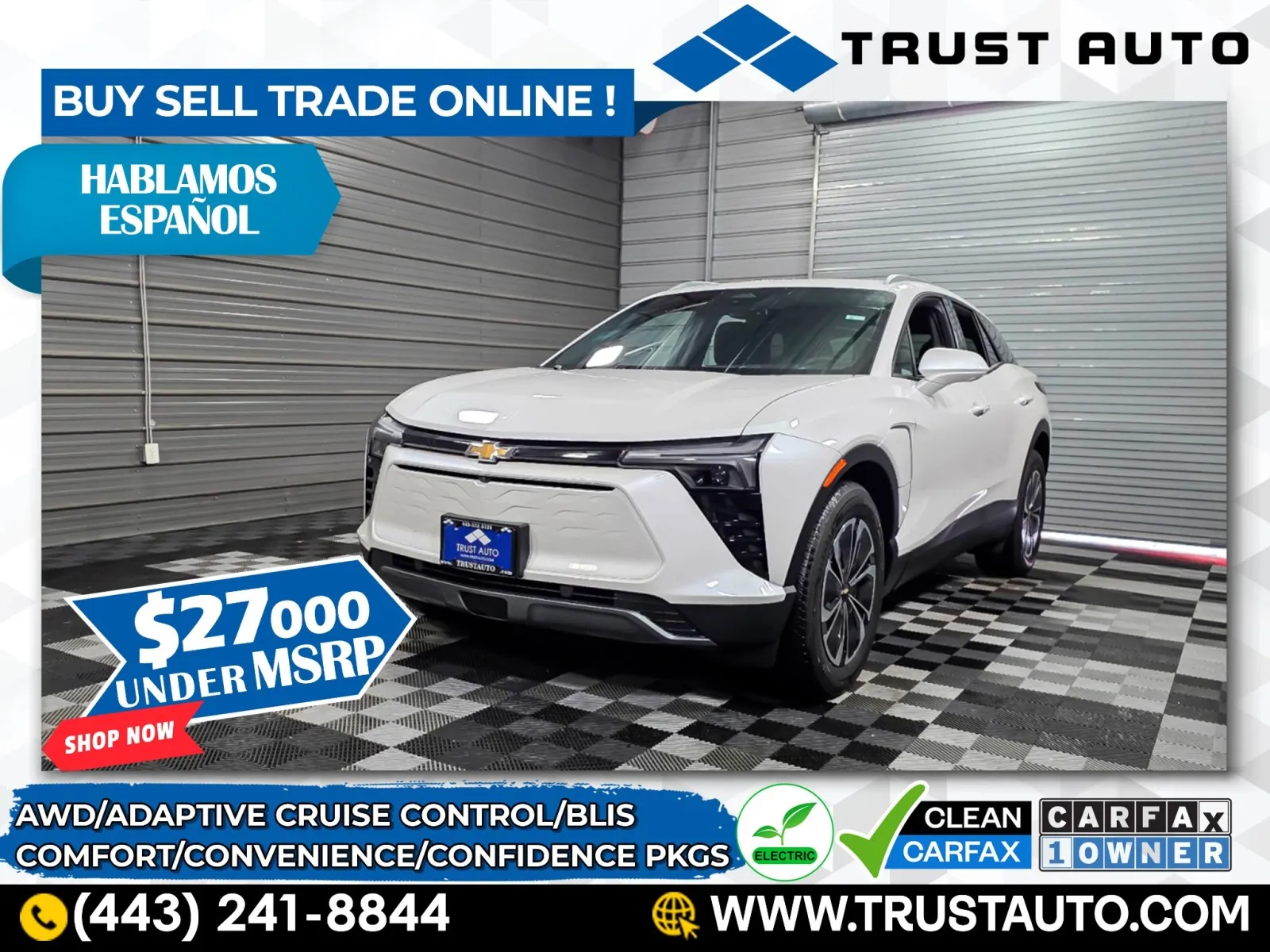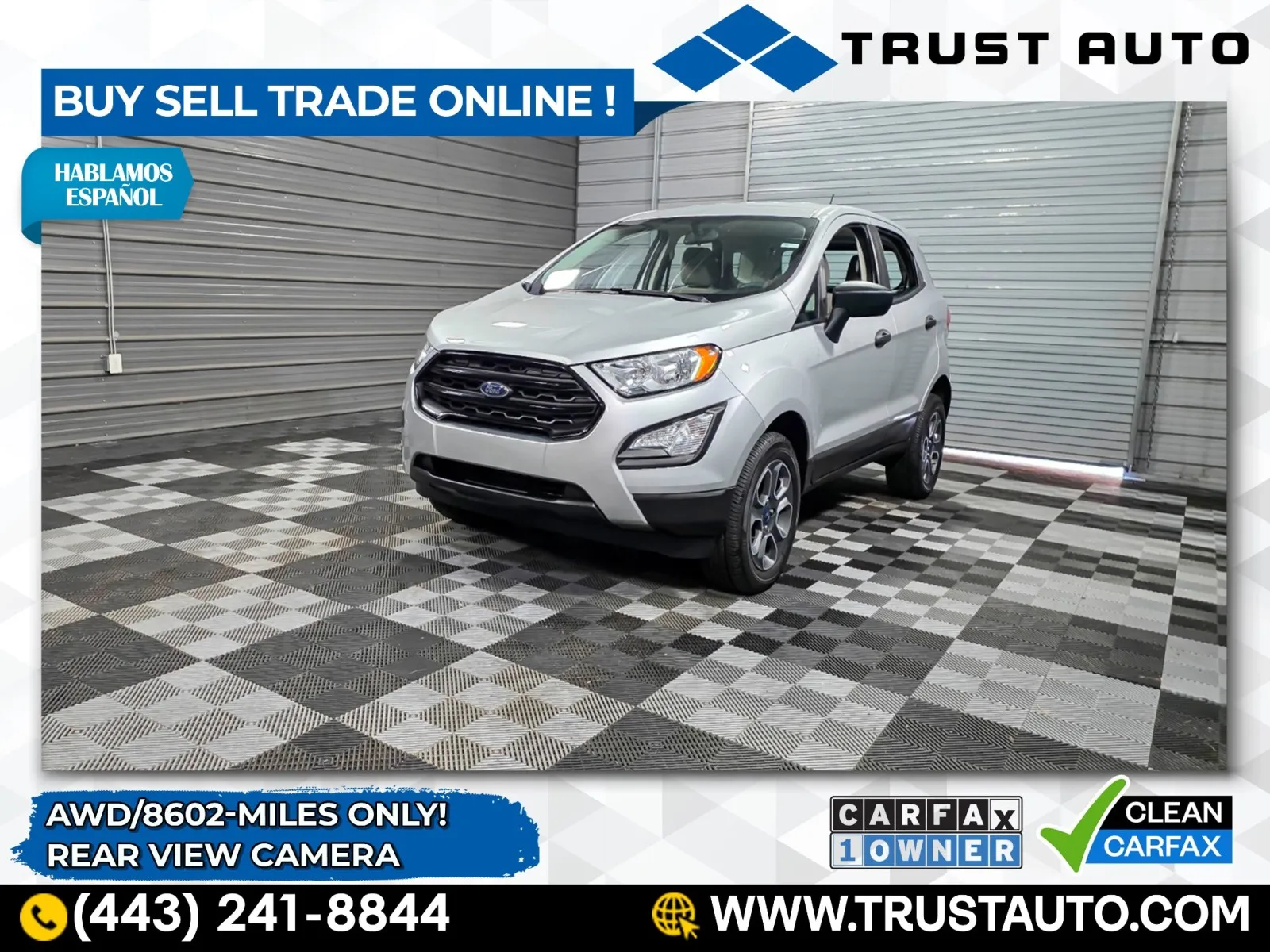AWD Vs. 4WD: The Ultimate Guide
Table of Contents
- AWD Vs. 4WD: The Ultimate Guide
- What is All-Wheel Drive?
- What is Four-Wheel Drive?
- AWD Advantages and Disadvantages
- Advantages of an AWD System
- Disadvantages of an AWD System
- 4WD Advantages and Disadvantages
- Advantages of a 4WD System
- Disadvantages of a 4WD System
- AWD Vs. 4WD in Snow and Other Road Conditions
- AWD or 4WD: Which To Buy?
- Buying a Used AWD or 4WD Vehicle at Trust Auto

AWD Vs. 4WD: The Ultimate Guide
Think of all-wheel drive (AWD) and four-wheel drive (4WD) as two different ways of doing the same thing: improving a vehicle’s road handling ability. No doubt, each system increases a car’s versatility and grip. But apart from that, there are a host of differences between the way AWD and 4WD work.
Read on as we discuss all the contrasts in detail and review the advantages and disadvantages of each system.
What is All-Wheel Drive?
An all-wheel-drive system is drivetrain technology designed to send power to all four wheels. However, there’s no guarantee that the power shared between them is consistent or equally divided, which means that an all-wheel drivetrain can deliver power between all four wheels or just two wheels on a single axle.
AWD systems often switch to rear-wheel drive to achieve higher fuel economy. For example, when going down the highway or cruising on a straight road, most of the power is transferred to the rear wheels.
But when the surface gets loose and more grip and traction is needed, the AWD system starts to transfer power to all four wheels. It uses variable torque distribution where the power transmitted can be equal or varying depending on where and how you drive.
Many high-performance cars with all-wheel drive have the inner front wheel rotating slower than other wheels during cornering. This is because the outer wheels have to travel a greater distance than the inner wheel. This enables a car to take sharp corners more quickly.
All of this is controlled by the car’s computer that continuously monitors individual wheel rotation speed. Depending on the changes, the system adapts to deliver as much traction as possible.
What is Four-Wheel Drive?
Four-wheel drive is also a drivetrain with the ability to power all four wheels. But unlike AWD, 4WD can’t constantly switch between 4WD and rear-wheel drive (RWD). Instead, it is by default set in RWD mode and then manually changed to 4WD.
So, for example, if you own a 4WD, your vehicle will mainly stay in RWD mode for everyday driving. Then, as you need more traction and grip, you would manually put the drivetrain into 4WD mode either by changing gear, pressing a button, or rotating a knob.
Whereas all-wheel-drive distributes torque variably among the wheels, 4WD locks the differentials, basically locking the front driveshaft in sync with the rear. This ensures that all wheels—front and rear—rotate at the same speed when you press the gas.
This is the reason why four-wheel drives are used in extreme off-road conditions. By locking the differentials, all wheels rotate at the same speed and traction is never lost due to over spinning.
What you get in 4WD is an option between 4 High (4H) and 4Low (4L). In 4H mode, you have a higher gear ratio, meaning the engine will rev higher, and all four wheels will spin faster. This is a mode you use when you need speed over traction, like when climbing a slope. In 4L, the gear ratio is lower, and the wheel spins slower. This is suited for driving on soft and loose surfaces like snow or sand, where traction is needed over speed.
AWD Advantages and Disadvantages
Advantages of an AWD System
Better traction: An all-wheel-drive system always provides better traction than any other drivetrain. Despite the variable condition of the road, the system constantly adapts and improves overall traction. When it detects slippage, the power is transferred to other wheels to compensate.
Improved performance: An all-wheel-drive car has better acceleration than RWD or 4WD. Since all four wheels accelerate simultaneously, there is no wheel spin when you pull hard. The vehicle doesn’t overspin when cornering as the wheels move at different speeds to maintain traction. Hence, improving the overall handling.
Higher Resale Value: All-wheel drive vehicles are higher-performing vehicles that are easier to sell. The ability to handle variable terrain and conditions makes these cars more desirable. Plus, AWD gives these vehicles a high resale value than comparable ones with two-wheel drive (2WD).
Disadvantages of an AWD System
Lower fuel economy: The one major drawback of AWD is its reduced fuel economy. The engine needs to produce more power to operate all four wheels. And, an AWD vehicle is heavier than a comparable two-wheel-drive model. On average, an AWD car consumes about 10 percent more fuel.
Higher cost of ownership: AWD is more costly to maintain mainly because of the complex drivetrain. Sensors need periodic maintenance, and repairs can be expensive, too.
4WD Advantages and Disadvantages
Advantages of a 4WD System
A choice between 2WD and 4WD: Unlike AWD that automatically switches between modes. A 4WD system always gives you an option between 2WD and 4WD. Meaning in normal conditions, you can always drive in 2WD to save fuel.
Better off-road capability: A 4WD system inherently has way better off-roading handling than AWD. Its ability to lock differentials limits the wheels from overspeeding and losing traction. Even when a wheel is not in contact with the surface (like when one wheel is lifted), the other rotates at the same speed, which adds to the traction and vehicle control.
Improved power delivery: As mentioned earlier, a 4WD system can switch between 4H or 4L gear ratios. This not only improves vehicle handling but also gives better control of power delivery.
When higher power is needed, the 4H provides a higher power range with longer gear ratios. Allowing you to pull in one gear for a longer time. When less power and higher traction are needed, 4L restricts the powerband with a lower shift ratio. In this case, the engine hits the limiter faster, limiting the wheels from spinning faster.
Disadvantages of a 4WD System
Locking and winding issues: Four-wheel drives are driven in 2WD in the city to prevent transmission winding. This occurs during higher-speed 4WD cornering as the inner wheel rotates less compared to outer wheels. This difference in wheel speed jams the transmission gear causing a windup effect and significant understeer (which can create a driving hazard).
Higher Cost: 4WD, while cheaper than AWD, is still costlier than 2WD. Plus, a 4WD vehicle is heavier, consumes more fuel, and is more expensive to buy (compared to 2WD). The cost of maintenance of 4WD is higher as well.
AWD Vs. 4WD in Snow and Other Road Conditions
AWD and 4WD drive are both designed to offer better traction than conventional 2WD. With AWD, every time your vehicle encounters a slippery or loose surface causing a loss of traction, it adjusts the power delivery to provide a better grip. However, while the drivetrain enables the vehicle to gain more traction, much of this ability dramatically depends on the type of tires you use.
The same is applicable with a 4WD system. Yes, it does enable you to have extreme off-roading ability and tackle harsher terrain, but the vehicle still needs to have proper tires. The point where actual difference is seen, however, is in their application.
AWD is a highly versatile system that is used from small family cars to high-performance sports cars. Its simple ability of variable torque delivery makes it superior to every other mechanism. With AWD, you can rest assured that you will never over or understeer.
Even on rough, slippery surfaces such as snow, mud, or sand, an AWD system can bring a lot of grip and control with the right sets of tires. But where AWD fails is in extreme situations. Conditions with foot-deep mud or snow, big water puddles, and steep inclines. This is where 4WD shines due to its off-road capabilities. Unlike AWD that works on sensors, 4WD works on mechanical locks. This makes 4WD a lot tougher and durable in extreme conditions.
AWD or 4WD: Which To Buy?
Between AWD and 4WD, or even compared to front-wheel drive or RWD, AWD is usually the best choice, such as when buying a standard vehicle such as a sedan, sports car, or crossover. As long as you are driving on paved roads or normal surfaces, AWD is great. This configuration is helpful for modest off-roading as well.
But if you’re buying a vehicle for adventure and tackling rough surfaces or heavy-duty work use, then 4WD is the right buy. You can drive on roads in 2WD mode and switch to 4WD when dealing with harsher terrains; 4WD will give you more versatility in these situations.
Check out our latest inventory of AWD and 4WD vehicles . All vehicles are subject to prior sales.
Buying a Used AWD or 4WD Vehicle at Trust Auto
Whether you enjoy the performance advantages of AWD or need the rugged capability of 4WD, Trust Auto in Sykesville is the used car dealer to visit. Review our entire online inventory of high-quality SUVs, trucks, and cars.
Buying a used SUV in Randallstown? Looking for a used crossover in Columbia? Then the best used AWD and 4WD cars for sale are close by at Trust Auto. We’re also convenient for car buyers from Virginia and Washington, DC. Searching for a used car in Pennsylvania? Looking for a used truck in New York? Discover how our remote shopping can deliver the perfect AWD or 4WD direct to your door. This virtual experience is ideal if you live in Towson, Eldersburg, Damascus, or anywhere else.
From Baltimore and beyond, Trust Auto is the must-visit used car dealership. Call, click, or visit for the best-used cars at the best prices.











